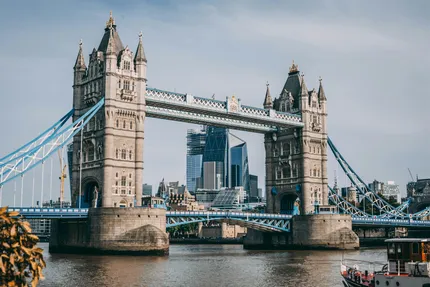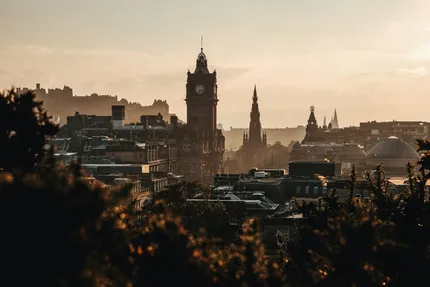CityTouring
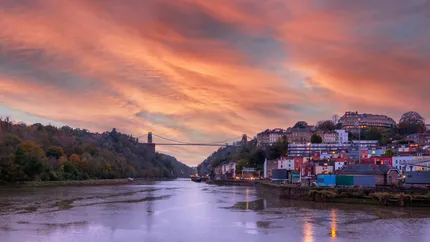
City trip to Bristol
United KingdomBristol straddles the River Avon and Floating Harbour, mixing industrial heritage with a creative, independent streak. Start at the Harbourside, where cafes, bars, and cultural venues fill old warehouses. Board Brunel's SS Great Britain, trace the city's maritime story at M Shed, or see contemporary art at Arnolfini and Spike Island. Ferries shuttle between sights, adding easy, scenic transport. Above the gorge, the Clifton Suspension Bridge frames views from elegant Clifton Village and the Georgian terraces around Royal York Crescent; Brandon Hill's Cabot Tower offers another compact skyline lookout. Bristol is also a capital of street art: Banksy's home city rewards self-guided or guided walks through Stokes Croft and Bedminster.
Eating is strong and casual-first, from the CARGO shipping containers at Wapping Wharf to global bites in St Nicholas Market. Evenings stretch from pubs on cobbled King Street and cider boats on the harbour to the Bristol Beacon, Thekla, and late nights at Motion. The city centre is walkable, buses are frequent, and most neighborhoods sit within a short hop of each other.
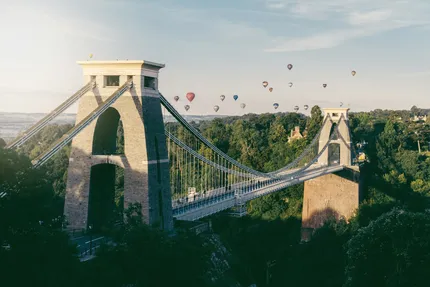
Clifton Suspension Bridge
Brunel’s 19th‑century suspension bridge spans the dramatic Avon Gorge, offering sweeping views across the city and countryside. Walk across the deck, visit the free Visitor Centre to learn its engineering story, and head to nearby viewpoints like Observatory Hill. Illuminated at night, it’s Bristol’s defining landmark and a perfect first stop.

Street Art and Banksy Trail
Discover Bristol’s world‑renowned street art on self‑guided or guided walks through Stokes Croft, Nelson Street, and Bedminster. Spot works by Banksy and leading global artists, explore Upfest murals, and learn about the city’s creative culture and activism. New pieces appear frequently, so even repeat visitors find fresh walls, stories, and photo opportunities.
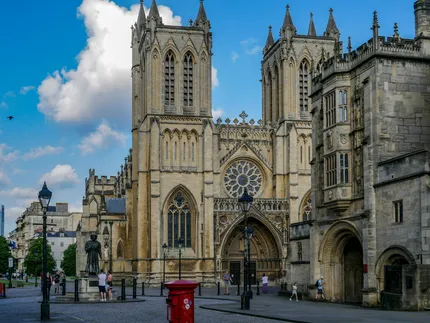
Bristol Cathedral
Set on College Green, this impressive cathedral blends Norman foundations with soaring Gothic architecture. Step inside for intricate stonework, a beautiful nave and choir, medieval cloister, and tranquil garden. Free to enter, it hosts regular choral services and concerts. Combine with a stroll past the University, City Hall, and nearby Park Street.
Bristol is a strong fit for travelers who like their city breaks hands-on and independent. Street art fans can devote a day to murals in Stokes Croft, Nelson Street, and Bedminster, joining a local tour to understand the artists beyond Banksy. Engineering and history enthusiasts get rare depth: Brunel's SS Great Britain is immersive, the Clifton Suspension Bridge Visitor Centre explains its design, and Aerospace Bristol in Filton displays the last Concorde you can board. Families with school-age children do well here with engaging, compact attractions such as harbour ferries, the interactive Dockyard Museum at SS Great Britain, M Shed, Bristol Aquarium, and deer-spotting and cycling at Ashton Court Estate.
Music lovers and night owls find range: intimate gigs at Thekla or The Fleece, orchestral and touring acts at the refurbished Bristol Beacon, club nights at Motion, and trad jazz at The Old Duke on King Street. Food-minded travelers can graze at St Nicholas Market, sample local cider at The Apple, and move between modern restaurants and casual counters at Wapping Wharf's CARGO. Craft-beer fans have notable options, including Left Handed Giant at Finzels Reach, Moor Beer near Temple Meads, and Wiper and True's Old Market taproom. Active visitors can book paddleboarding in the harbour, walk the gorge at Leigh Woods, climb Brandon Hill for views, or cycle part of the Bristol and Bath Railway Path. The city's scale suits two to three days without a car.
Three top reasons for a city trip to Bristol
- Stand beneath Clifton Suspension Bridge, gaze across the Avon Gorge, then board Brunel's SS Great Britain and visit adjacent Being Brunel museum, immersing yourself in Bristol's world-changing Victorian engineering legacy.
- Wander Bristol's Floating Harbour: ride Bristol Ferry, explore M Shed, browse Arnolfini, dine at Wapping Wharf's Cargo containers, and watch dockside cranes frame sunset views over the water at night.
- Trace Banksy's roots on Bristol's art trail through Stokes Croft and Bedminster's Upfest murals, browse independents along Gloucester Road, then celebrate at Ashton Court's Bristol International Balloon Fiesta Night Glow.
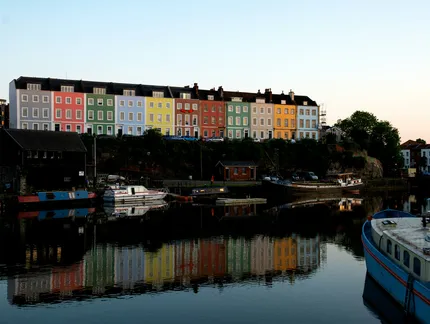
Best time to visit Bristol
The most rewarding months are late May through early September, when daylight is long, outdoor venues buzz, and average highs sit around 18-22C. Signature events cluster then: the Harbour Festival fills the docks in July, and the Bristol International Balloon Fiesta brings mass ascents over Ashton Court in August, weather permitting. Early June often sees major street art activity in Bedminster and Southville, and waterside bars and ferries run frequent schedules. For fewer crowds and lower prices, consider mid-September to early October: temperatures remain mild and foliage starts to turn. Winter is mild but wet; December's city-centre Christmas market adds seasonal atmosphere.
More activities and things to see in Bristol:
Brunel’s SS Great Britain
Explore Brunel’s revolutionary 1843 steamship in its original dry dock. The award‑winning museum recreates Victorian cabin life, engine rooms, and ocean voyages, with atmospheric sights and smells. Don’t miss the “Being Brunel” galleries next door, interactive exhibits, and harbourside views from the weather deck. It’s an immersive, family‑friendly highlight of maritime history.
Harbourside and Wapping Wharf
Stroll the revitalised docks where cranes, warehouses, and cobbled quays meet waterfront restaurants, bars, and cultural venues. Visit Millennium Square, Arnolfini, and M Shed, sample street food at Cargo shipping‑container units, and hop on a ferry for a scenic loop. It’s a lively base for walking or cycling, day and evening.
M Shed
Located on the harbour, M Shed is Bristol’s social‑history museum, telling stories of the city’s people, industry, and activism. Exhibits cover trade, music, and migration, with interactive displays and striking local photography. Outside, historic cranes and heritage boats bring the docks to life, and occasional working demonstrations run on weekends.
St Nicholas Market
Browse Bristol’s oldest market inside the 18th‑century Corn Exchange and adjacent Glass Arcade. Expect independent stalls selling world street food, cheeses, spices, vinyl, books, crafts, and vintage finds. It’s an atmospheric lunch stop near the Old City’s narrow lanes, with easy access to nearby churches, historic pubs, and the quirky nails payment posts.
Bristol Museum and Art Gallery
A free, family‑friendly museum displaying fine art, archaeology, and natural history. Highlights include an impressive dinosaur collection, Egyptian mummies, wildlife exhibits, and paintings by Turner and the Pre‑Raphaelites. The Edwardian building itself is striking. Combine with nearby University buildings and Park Street for a cultural wander, plus cafés and bookshops.
Cabot Tower and Brandon Hill
Climb the spiral stairs of the 105‑foot Cabot Tower for panoramic views over the harbour, Clifton, and the hills beyond. Set within Brandon Hill’s landscaped park, it’s a good picnic spot with ponds, wildlife, and playgrounds. Free to access, it’s close to Park Street and makes a rewarding short detour.
Clifton Village and The Downs
Explore elegant Georgian terraces, boutique shops, and cafés in Clifton Village. Nearby, the Clifton Observatory offers camera‑obscura views and a cave walk to a cliffside balcony. Wander onto the vast open parkland of The Downs for clifftop paths above the Avon Gorge, running routes, and picnic space with sweeping vistas.
Aerospace Bristol and Concorde
Head to Filton to trace Bristol’s aerospace heritage, culminating with Concorde Alpha Foxtrot, the last Concorde built and flown. Exhibits cover early flight, wartime engineering, and modern aviation, with hands‑on displays for all ages. Step under Concorde’s sleek wings and onboard to explore the cabin and flight deck. Easy by bus or car.
Ashton Court Estate
Escape to Ashton Court’s vast park and woodlands just across the Suspension Bridge. Wander waymarked trails, spot roaming deer, and admire views back to the city. Activities include mountain‑bike trails, a miniature railway on select days, disc golf, and seasonal hot‑air balloon launches. Great for picnics and relaxed half‑day walks.
Getting around in Bristol
Bristol's centre, Harbourside, and Clifton are compact and walkable, though some steep hills can slow you down. Cycling is popular; there is a growing network of protected lanes, the traffic-free Bristol and Bath Railway Path, and widespread secure parking. App-based shared e-bikes and e-scooters supplement private bikes. First Bus runs dense city services, plus fast, limited-stop Metrobus routes (m1, m2, m3) with off-board ticketing and contactless capping; real-time info is common at major stops. Local trains from Temple Meads link Bath, Weston-super-Mare, Filton, and the scenic Severn Beach line; Temple Meads is also the hub for regional rail. Ferries along the Floating Harbour offer a pleasant cross-harbour shortcut. Taxis and ride-hailing are widely available. Traffic and parking can be difficult, and a Clean Air Zone applies in the centre for some vehicles, so a car is rarely the easiest choice. Park-and-ride sites on main approaches help if you are driving. Overall, most visitors do well combining walking, transit, and bikes.
Getting to Bristol
Bristol Airport (BRS) lies about 13 km south of the city and is the main gateway. Frequent A1 Airport Flyer buses connect the terminal with Temple Meads station and the city centre in around 30-40 minutes; the Stagecoach Falcon coach also links the airport with Bristol, Taunton, Exeter, and Plymouth. BRS has extensive UK and European flights on easyJet, Ryanair, Jet2, and TUI. For long-haul, connect via hubs such as Amsterdam Schiphol (KLM) or Dublin, which offer onward global networks. By train, Bristol Temple Meads is the primary long-distance station, with Great Western Railway services to London Paddington (about 1h30-1h50), Bath, Cardiff and South Wales, the Cotswolds, and the South West, plus CrossCountry trains to Birmingham, the Midlands, Manchester, and the North East. International rail is via London: travel to Paddington, then transfer to St Pancras for Eurostar. National Express and Megabus operate frequent long-distance coaches to London, Heathrow, Birmingham, Cardiff, and other UK cities, often budget-friendly.
